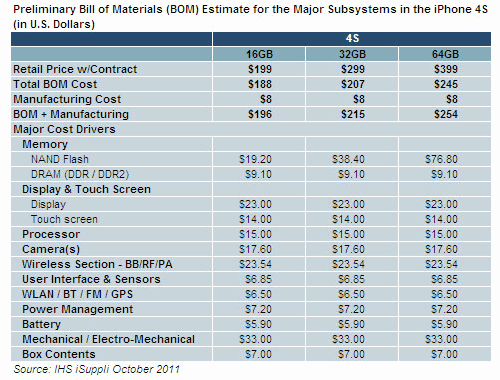Maybe you paid $200 for a 16 GB iPhone 4S, or another $100 for the 32 GB version. Maybe you were already under contract and not eligible for an upgrade, broke open the piggybank, and forked over $649 for the 16 GB model. Whatever the case, want to know what Apple’s paying to put these things together? About what else—and I’m talking stuff you probably haven’t heard about—might be under the hood?
iSuppli, known for its gadget component costs analyses, just released its breakdown (or “teardown”) of the iPhone 4S. The report looks at hardware costs exclusively, and iSuppli cautions they’re not including related expenses, like software, licensing and royalties.
(MORE: The iPhone 4S Cracked Open, Innards Analyzed)
Let’s start with the 16GB model, which iSuppli says has a bill of materials (BOM) totaling $188—a trifling $0.50 more than the iPhone 4’s estimated BOM. Add an $8 manufacturing cost and that increases to $196. Here’s the full chart, including the 32GB and 64 GB models, with $207 and $245 BOM’s respectively.
As you can see, the only differentiator between the 16, 32 and 64 GB models is the NAND flash, which doubles in cost as you step from 16 to 32, and again from 32 to 64.
“While the iPhone 4S shares many common design elements with the two iPhone 4 models already on the market, the new device’s status as a world phone has resulted in fascinating design and component changes,” said Andrew Rassweiler, senior director of teardown services for IHS (which owns iSuppli). “Key among these changes is a custom part from Avago that helps give the iPhone 4S its unique capability to be used in multiple wireless systems globally, while still keeping costs down.”
Rassweiler notes the 4S uses a “Hynix NAND flash memory device,” which he calls “surprising” because it’s the first time parts from Samsung and Toshiba—found in prior iSuppli iPhone and iPad teardowns—haven’t appeared in an iPhone.
Other notable upgrades: The iPhone 4S’s wireless system is “a significant upgrade” over prior models, thanks to its dual-mode design (this would be the 4S’s “world phone” multi-carrier capability). There’s also an Avago power amplifier in the 4S that supports 2G and 3G “across multiple bands thus reducing the number of components and PC board footprint required”—iSuppli says it’s the first time Apple’s included the tech in an iOS device. Interestingly, the baseband processor (for global wireless) in the 4S is from Qualcomm, no longer sharing a spot with Intel, which Apple used in the HSPA (high speed packet access) version of the original iPhone 4.
And last but not least, you’ve got the camera, which we already know bumps from 5 to 8-megapixels, but what about the improved sensor? According to iSuppli, “The camera uses a backside illumination (BSI) image sensor that improves photo quality, especially in low light, but also adds cost to the system.”
MORE: The Incredibly Cheap $100 Nintendo 3DS
Matt Peckham is a reporter at TIME. Find him on Twitter at @mattpeckham or on Facebook. You can also continue the discussion on TIME’s Facebook page and on Twitter at @TIME.


